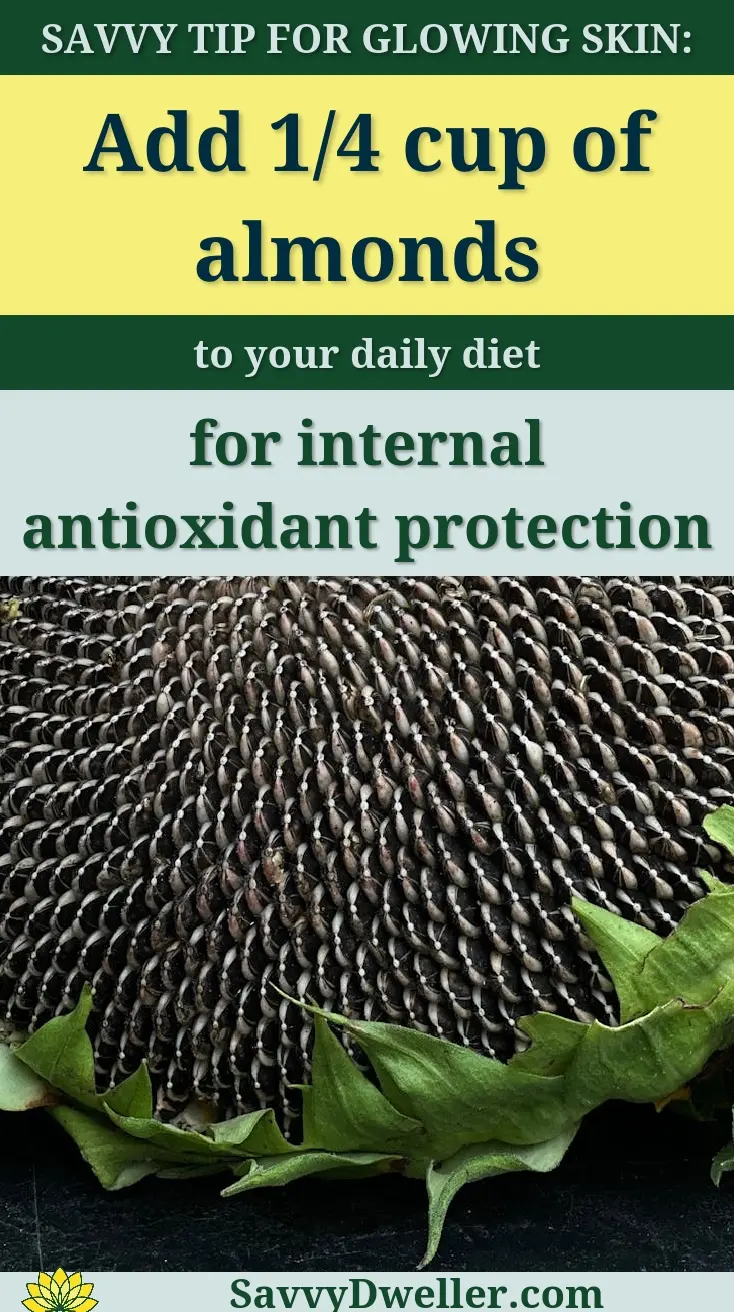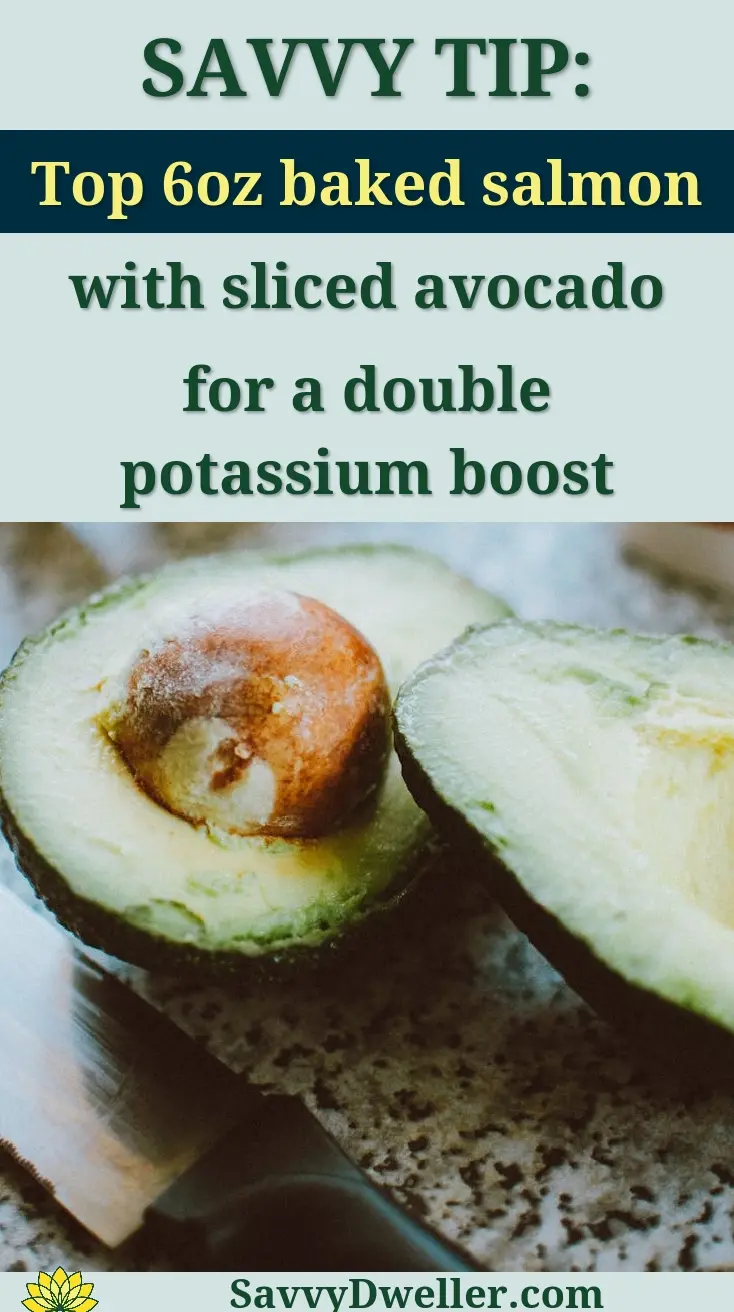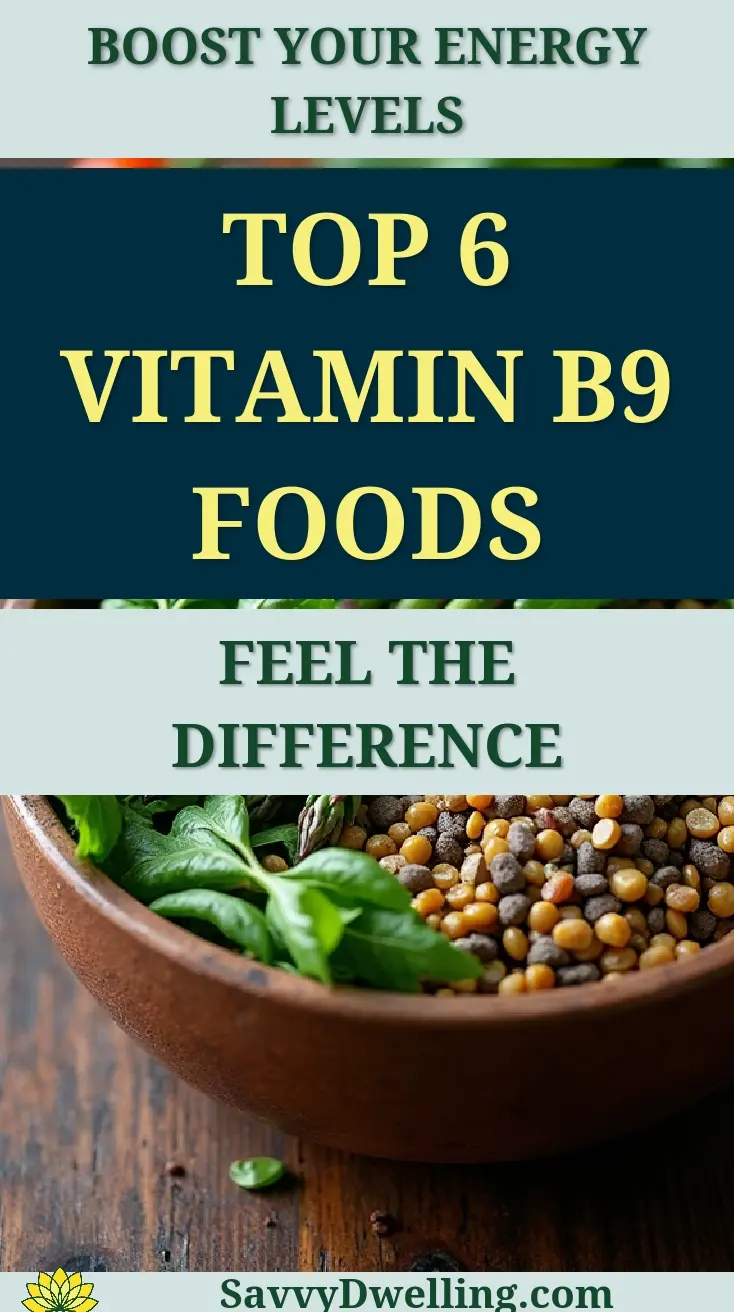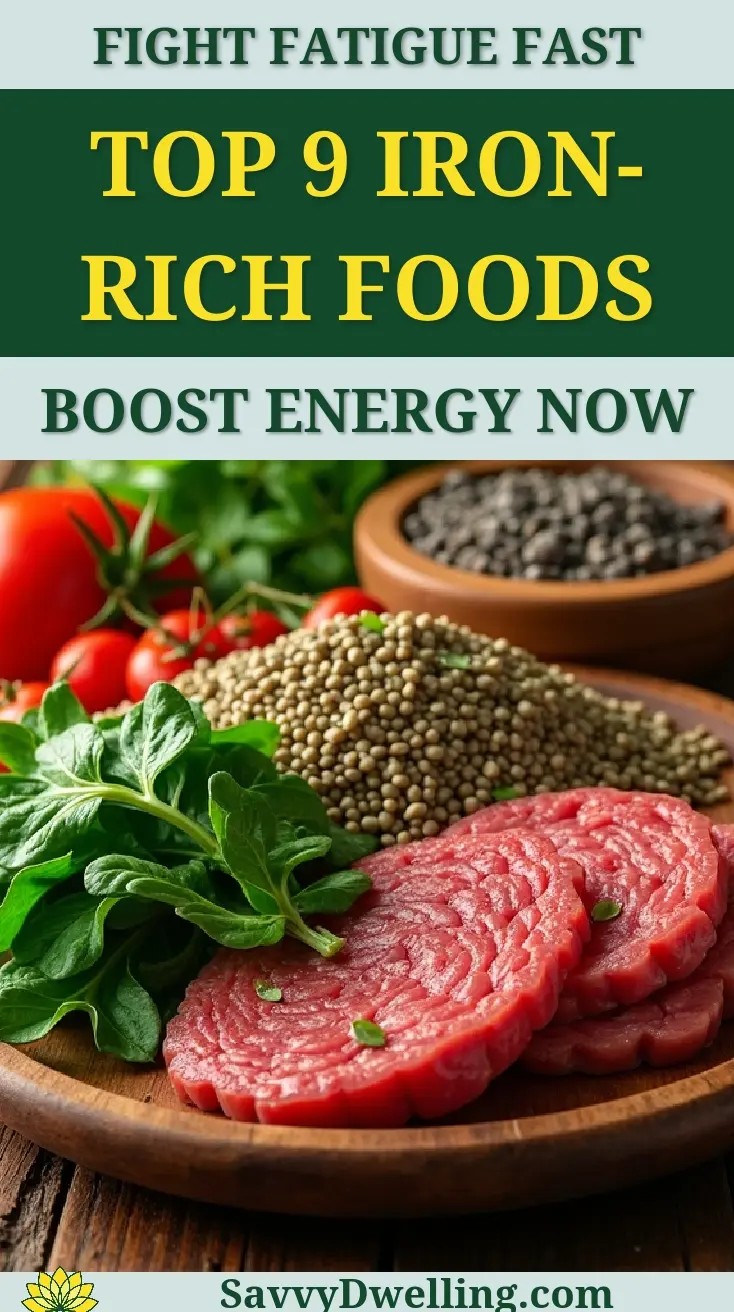The Top 10 Potassium-rich Foods for a Healthy Heart
Have you been feeling more concerned about your heart health lately, or noticed your blood pressure readings creeping upward? You’re not alone in wanting to support your cardiovascular system naturally through better food choices. Many people struggle with knowing which foods truly make a difference for heart health beyond the usual “eat more vegetables” advice.
This guide breaks down the ten most potassium-packed foods that can genuinely support your heart’s daily function, complete with exact amounts and practical preparation tips you can use immediately. We’ve researched the science and simplified it into actionable meal ideas that fit into your real life, not a perfect nutrition textbook.
Contents
- At a Glance: The Best Potassium-rich Foods for Heart Health
- 1. Sweet Potatoes (700mg Per Medium Potato)
- 2. White Beans (1,189mg Per Cup)
- 3. Spinach (840mg Per Cup Cooked)
- 4. Avocados (975mg Per Whole Avocado)
- 5. Bananas (422mg Per Medium Banana)
- 6. Potatoes (610mg Per Medium Potato With Skin)
- 7. Tomatoes (440mg Per Cup)
- 8. Beets (518mg Per Cup)
- 9. Greek Yogurt (573mg Per Cup)
- 10. Salmon (628mg Per 6oz Serving)
- The Science Made Simple: How Potassium Supports Heart Health
- Smart Kitchen Tips for Maximizing Potassium Intake
- Common Mistakes to Avoid When Adding Potassium to Your Diet
- Frequently Asked Questions
- Final Words
- Sources:
At a Glance: The Best Potassium-rich Foods for Heart Health
When you’re looking to support your heart health naturally, potassium-rich foods offer some of the most powerful nutrition you can find. This essential mineral works quietly behind the scenes to help regulate blood pressure and maintain steady heart rhythms.
The foods we’ve selected represent the top potassium sources that are both accessible and delicious. Each one provides substantial amounts of this heart-supporting mineral while offering additional nutrients your cardiovascular system craves.
| Food | Potassium Content | Serving Size | Additional Heart Benefits |
|---|---|---|---|
| White Beans | 1,189mg | 1 cup cooked | High fiber, plant protein |
| Avocados | 975mg | 1 whole avocado | Healthy fats, folate |
| Spinach | 840mg | 1 cup cooked | Magnesium, nitrates |
| Sweet Potatoes | 700mg | 1 medium potato | Beta-carotene, fiber |
| Salmon | 628mg | 6oz serving | Omega-3 fatty acids |
| Potatoes | 610mg | 1 medium with skin | Vitamin C, fiber |
| Greek Yogurt | 573mg | 1 cup plain | Protein, probiotics |
| Beets | 518mg | 1 cup cooked | Nitrates, folate |
| Tomatoes | 440mg | 1 cup chopped | Lycopene, vitamin C |
| Bananas | 422mg | 1 medium banana | Vitamin B6, fiber |
These top potassium-rich foods can help you reach the recommended daily intake of 3,500-4,700mg that supports optimal heart function. Notice how white beans top the list with nearly 1,200mg per cup – that’s about a quarter of your daily needs in just one serving.
The beauty of these potassium sources lies in their versatility. You can easily incorporate multiple options into a single meal, creating delicious combinations that multiply your heart-health benefits throughout the day.
1. Sweet Potatoes (700mg Per Medium Potato)
Why They Support Heart Health
Sweet potatoes pack a powerful punch when it comes to supporting your cardiovascular system. A single medium sweet potato delivers nearly 20% of your daily potassium needs, making it one of the most reliable potassium-rich foods you can add to your diet.
Beyond their impressive potassium content, sweet potatoes contain beta-carotene and fiber that work together to support healthy blood pressure levels. The natural sugars digest slowly, preventing the blood sugar spikes that can strain your heart over time.
The vibrant orange color signals high antioxidant levels that may help protect your blood vessels from inflammation. This combination of nutrients makes sweet potatoes a standout choice among foods high in potassium for heart health.
Best Ways to Prepare Sweet Potatoes
Roasting brings out sweet potatoes’ natural sweetness while preserving their potassium content better than boiling. Keeping the skin on doubles your fiber intake and adds extra potassium to every bite.
Here are the most heart-friendly preparation methods:
- Bake whole at 425°F for 45-60 minutes until tender
- Cube and roast with olive oil and herbs for 25-30 minutes
- Steam cubes for 12-15 minutes to retain maximum nutrients
- Grill thick slices for a smoky flavor that pairs well with lean proteins
Avoid deep frying or adding excessive butter, which can counteract the heart benefits you’re seeking from these potassium sources.
Easy Sweet Potato Recipes for Heart Health
Transform sweet potatoes into satisfying meals that support your cardiovascular goals. These simple recipes maximize the potassium benefits while keeping preparation time minimal.
Stuffed Sweet Potato Bowl: Top a baked sweet potato with black beans, diced avocado, and a sprinkle of pumpkin seeds for a meal rich in potassium and heart-healthy fats.
Sweet Potato Hash: Dice and sauté sweet potatoes with bell peppers and onions in olive oil. Crack an egg on top for protein that complements the potassium-rich vegetables.
Roasted Sweet Potato Salad: Combine cubed roasted sweet potatoes with spinach, walnuts, and a light vinaigrette for a nutrient-dense side dish that delivers multiple potassium sources in one bowl.

2. White Beans (1,189mg Per Cup)
How White Beans Aid Cardiovascular Function
White beans top the charts among potassium-rich foods, delivering nearly one-third of your daily potassium needs in a single cup. This impressive potassium content works alongside their high fiber and magnesium levels to support healthy blood pressure and heart rhythm.
The soluble fiber in white beans helps remove cholesterol from your bloodstream before it can build up in your arteries. Meanwhile, their plant-based protein provides sustained energy without the saturated fat found in many animal proteins.
Research suggests that people who regularly eat beans have lower rates of heart disease. The combination of potassium, fiber, and folate in white beans creates a powerful trio for cardiovascular protection.
Simple Preparation Methods
Cooking dried white beans from scratch maximizes their nutritional value and lets you control sodium levels. Soaking beans overnight reduces cooking time and makes them easier to digest.
Follow these steps for perfectly cooked white beans:
- Sort through dried beans, removing any stones or damaged beans
- Rinse thoroughly and soak in water for 8-12 hours
- Drain soaking water and rinse again
- Place beans in a pot with fresh water covering them by 2 inches
- Bring to a boil, then reduce heat and simmer for 45-90 minutes until tender
- Add salt only during the last 15 minutes to prevent tough skins
Canned white beans offer convenience while still providing excellent potassium levels. Rinse them thoroughly to reduce sodium by up to 40%.
Heart-healthy White Bean Meal Ideas
White beans adapt beautifully to both warm and cold dishes, making them versatile additions to your potassium-rich diet. Their creamy texture and mild flavor complement many ingredients.
White Bean and Vegetable Soup: Simmer white beans with diced tomatoes, carrots, and spinach in low-sodium broth for a comforting meal that combines multiple foods rich in potassium.
Mediterranean White Bean Salad: Mix cooked white beans with diced cucumber, cherry tomatoes, and fresh herbs. Dress with olive oil and lemon juice for a refreshing side dish.
White Bean Hummus: Blend cooked white beans with garlic, lemon juice, and olive oil for a protein-rich spread that delivers potassium benefits with every bite.
Also See: 10 Surprising Foods That Are Secretly High in Sugar
3. Spinach (840mg Per Cup Cooked)
Spinach’s Role in Blood Pressure Support
Spinach stands out among leafy greens as one of the top potassium-rich foods for cardiovascular health. The potassium in spinach works with its natural nitrates to help relax blood vessel walls and support healthy circulation.
This powerhouse green also provides magnesium and folate, two nutrients that work synergistically with potassium to maintain steady blood pressure levels. The combination creates a natural support system for your cardiovascular function.
Regular spinach consumption may help counteract the blood pressure-raising effects of sodium in your diet. The high potassium content helps your kidneys eliminate excess sodium more efficiently.
Fresh Vs. Cooked: Maximizing Potassium Content
Cooking spinach concentrates its nutrients, including potassium, making cooked spinach a more potent source than raw leaves. One cup of cooked spinach contains nearly double the potassium of the same amount of raw spinach.
The best cooking methods preserve potassium while making it more bioavailable:
- Light steaming for 2-3 minutes maintains most nutrients
- Quick sautéing with minimal water prevents potassium loss
- Adding spinach to soups and stews near the end of cooking
- Wilting fresh spinach directly into hot pasta or grain dishes
Avoid boiling spinach in large amounts of water, which can leach out valuable potassium and other water-soluble nutrients.
Quick Spinach Dishes for Daily Nutrition
Incorporating spinach into your daily meals doesn’t require complicated recipes. These simple preparations help you consistently benefit from spinach’s potassium content.
Green Smoothie Base: Blend fresh spinach with banana and your favorite fruits for a potassium-packed breakfast that masks spinach’s mild flavor completely.
Spinach and Egg Scramble: Wilt a handful of fresh spinach into scrambled eggs during the last minute of cooking for an easy way to boost your morning potassium intake.
Quick Garlic Spinach: Sauté spinach with minced garlic and a splash of olive oil for 2-3 minutes. This simple side dish pairs well with any protein and delivers concentrated potassium benefits.
4. Avocados (975mg Per Whole Avocado)
Avocado’s Heart-supporting Nutrients
Avocados stand out among potassium-rich foods by delivering nearly 1,000mg of this heart-supporting mineral in a single fruit. This creamy superfood provides more potassium than three medium bananas combined, making it one of the most concentrated potassium sources available.
Beyond their impressive potassium content, avocados contain monounsaturated fats that work synergistically with potassium to support cardiovascular health. These healthy fats help your body absorb fat-soluble vitamins while the potassium aids in maintaining healthy blood pressure levels. Incorporating avocados into your diet can also provide numerous health benefits. Specifically, they are known to contribute to heart health, improve digestion, and support weight management, making them a fantastic addition to any nutrition plan.
The magnesium and folate in avocados complement the potassium benefits by supporting proper heart rhythm and reducing inflammation in blood vessels. This triple combination makes avocados particularly effective for comprehensive heart health support.
Selecting and Storing Ripe Avocados
The ripeness of your avocado affects both taste and nutritional absorption, including potassium availability. A perfectly ripe avocado yields to gentle pressure but doesn’t feel mushy when squeezed near the stem end.
For immediate use, choose avocados with dark, bumpy skin that give slightly when pressed. If you’re planning ahead, buy firm avocados and let them ripen on your counter for 3-5 days at room temperature.
Store ripe avocados in the refrigerator for up to three days to slow further ripening. To speed up the ripening process, place unripe avocados in a paper bag with a banana or apple – the ethylene gas will accelerate ripening naturally.
Creative Ways to Add Avocado to Meals
Transform your meals with these heart-healthy avocado additions that maximize your potassium intake:
- Blend half an avocado into smoothies for creaminess without dairy
- Mash avocado with lemon juice and herbs as a spread for whole grain toast
- Dice avocado into salads, soups, or grain bowls for added richness
- Use avocado as a base for healthy chocolate mousse or puddings
- Stuff halved avocados with quinoa, beans, or lean proteins for complete meals
5. Bananas (422mg Per Medium Banana)
Why Bananas Are Heart-friendly
Bananas earn their reputation as one of the most accessible high potassium foods, providing over 400mg per medium fruit. This portable potassium powerhouse helps regulate blood pressure while providing natural sugars for sustained energy without the blood sugar spikes of processed snacks.
The fiber in bananas works alongside potassium to support heart health by helping to lower cholesterol levels. This dual action makes bananas particularly beneficial for people managing both blood pressure and cholesterol concerns.
Bananas also contain vitamin B6, which supports proper nerve function and helps your body utilize the potassium more effectively. This makes bananas one of the best potassium-rich foods for overall cardiovascular support.
Ripeness and Potassium Levels
The ripeness of your banana affects more than just sweetness – it impacts potassium availability too. Slightly underripe bananas with green tips contain the highest potassium levels, while overripe bananas convert more potassium into simple sugars.
Yellow bananas with small brown spots offer the perfect balance of potassium content and digestibility. At this stage, the starches have converted to natural sugars while maintaining most of the mineral content.
Green bananas contain resistant starch that supports digestive health, but they’re harder to digest and may cause stomach discomfort for some people. Choose your ripeness level based on your digestive comfort and potassium goals.
Beyond Snacking: Banana Recipe Ideas
Maximize your potassium intake with these versatile banana preparations:
- Freeze sliced bananas and blend them into instant “nice cream” with cocoa powder
- Mash overripe bananas into oatmeal or yogurt for natural sweetness
- Bake banana bread using whole wheat flour and minimal added sugar
- Grill banana halves with cinnamon for a heart-healthy dessert
- Add frozen bananas to protein smoothies for creaminess and potassium

6. Potatoes (610mg Per Medium Potato With Skin)
How Regular Potatoes Support Heart Health
Regular potatoes often get overlooked in discussions of potassium sources, yet they provide substantial amounts of this heart-supporting mineral. A medium potato with skin delivers over 600mg of potassium, making it more potent than many fruits traditionally considered high-potassium options.
The resistant starch in cooled, cooked potatoes acts as a prebiotic, feeding beneficial gut bacteria that produce compounds supporting heart health. This unique property makes potatoes valuable foods rich in potassium with additional cardiovascular benefits.
Potatoes also provide vitamin C and B6, which work synergistically with potassium to support proper nerve function and blood vessel health. This combination makes potatoes excellent choices for comprehensive heart support.
Skin-on Benefits for Maximum Nutrition
The potato skin concentrates much of the potassium and other nutrients, making it crucial to eat potatoes with their skin intact. Peeling potatoes removes approximately 20% of their potassium content along with valuable fiber and antioxidants.
Thoroughly scrub potatoes under running water with a vegetable brush to remove dirt and potential contaminants. Choose organic potatoes when possible to minimize pesticide exposure, especially since you’ll be eating the skin.
Small red or fingerling potatoes offer higher skin-to-flesh ratios, maximizing your potassium intake per serving. These varieties also tend to have thinner, more tender skins that are easier to digest.
Healthy Potato Cooking Methods
Preserve potassium content and support heart health with these preparation methods:
- Bake whole potatoes in their skins to retain maximum nutrients
- Steam cubed potatoes instead of boiling to prevent potassium loss
- Roast small potatoes with herbs and minimal olive oil
- Microwave pierced whole potatoes for quick, nutrient-preserving cooking
- Make mashed potatoes using the cooking liquid to retain dissolved potassium
7. Tomatoes (440mg Per Cup)
Tomatoes’ Cardiovascular Benefits
Tomatoes provide substantial potassium alongside lycopene, a powerful antioxidant that specifically supports heart health. One cup of fresh tomatoes delivers nearly 450mg of potassium while the lycopene helps protect blood vessels from oxidative damage.
The combination of potassium and lycopene in tomatoes creates synergistic effects for cardiovascular protection. Studies suggest this pairing may be more effective than either nutrient alone for supporting healthy blood pressure levels.
Tomatoes also contain folate and vitamin K, which work with potassium to support proper blood clotting and heart rhythm regulation. This makes tomatoes particularly valuable among potassium-rich foods for comprehensive heart support.
Fresh Vs. Canned: Potassium Content Comparison
Both fresh and canned tomatoes provide significant potassium, but processing affects the concentrations differently. Fresh tomatoes contain about 440mg per cup, while canned tomatoes often concentrate to 525mg per cup due to water removal during processing.
Choose low-sodium canned tomatoes to maximize potassium benefits without excessive salt intake. The sodium in regular canned tomatoes can counteract some of potassium’s blood pressure benefits.
Tomato paste offers the most concentrated potassium source, with over 600mg per quarter cup. However, watch portion sizes since tomato paste is typically used in smaller amounts than fresh or canned varieties.
Heart-healthy Tomato Preparations
Maximize both potassium intake and lycopene absorption with these preparation methods:
- Cook tomatoes with a small amount of olive oil to increase lycopene bioavailability
- Make fresh salsa combining diced tomatoes with potassium-rich avocados
- Roast cherry tomatoes until concentrated for maximum flavor and nutrients
- Prepare homemade tomato sauce using low-sodium canned tomatoes
- Add sun-dried tomatoes to salads and grain dishes for concentrated potassium
8. Beets (518mg Per Cup)
How Beets Aid Heart Function
Beets deliver a powerful combination of potassium and natural nitrates that work together to support healthy blood pressure levels. The nitrates in beets convert to nitric oxide in your body, which helps relax blood vessels and improve circulation.
This vibrant root vegetable also contains betalains, antioxidants that may help reduce inflammation in your cardiovascular system. When you combine these compounds with beets’ impressive potassium content, you’re giving your heart multiple layers of nutritional support.
Regular consumption of beets may help improve exercise performance and reduce the workload on your heart during physical activity. The natural sugars provide sustained energy while the potassium helps maintain proper heart rhythm during workouts.
Preparing Fresh Beets at Home
Fresh beets might seem intimidating, but they’re surprisingly simple to prepare once you know the basics. Start by choosing firm, smooth beets with vibrant color and intact greens if possible.
- Wash beets thoroughly and trim the greens, leaving about an inch of stem
- Wrap individual beets in aluminum foil with a drizzle of olive oil
- Roast at 400°F for 45-60 minutes until tender when pierced with a fork
- Let cool, then rub off the skin with a paper towel
- Slice or dice as needed for your recipe
Don’t toss those beet greens – they contain even more potassium than the roots and make excellent sautéed sides. Simply wash them well and cook like you would spinach or kale.
Delicious Beet Recipes for Heart Health
Transform beets into meals that make this potassium-rich food irresistible. These preparations maximize both flavor and nutritional benefits while keeping your heart health goals on track.
- Golden Beet and Goat Cheese Salad: Combine roasted golden beets with mixed greens, crumbled goat cheese, and walnuts
- Beet Hummus: Blend roasted beets into your favorite hummus recipe for a stunning pink dip packed with potassium
- Pickled Beet and Apple Slaw: Quick-pickle thinly sliced beets with apple cider vinegar for a tangy side dish
- Beet and Berry Smoothie: Blend cooked beets with frozen berries, Greek yogurt, and a splash of orange juice
9. Greek Yogurt (573mg Per Cup)
Greek Yogurt’s Heart-supporting Properties
Greek yogurt stands out among potassium foods because it also delivers high-quality protein and beneficial probiotics for overall cardiovascular health. The straining process that creates Greek yogurt concentrates both the protein and potassium content compared to regular yogurt.
The protein in Greek yogurt helps stabilize blood sugar levels, preventing the spikes and crashes that can strain your cardiovascular system. Meanwhile, the potassium works alongside calcium to support healthy blood pressure regulation.
Research suggests that the probiotics in Greek yogurt may help reduce inflammation markers associated with heart disease. When you choose Greek yogurt as one of your regular potassium-rich foods, you’re supporting both heart health and digestive wellness simultaneously.
Choosing the Best Greek Yogurt Options
Not all Greek yogurts are created equal when it comes to maximizing potassium benefits for heart health. Focus on plain varieties to avoid added sugars that can counteract the cardiovascular benefits.
- Plain, full-fat Greek yogurt: Provides the most potassium and helps with nutrient absorption
- Organic options: Often have higher potassium content due to better farming practices
- Avoid flavored varieties: Added sugars can negate heart health benefits
- Check protein content: Look for at least 15g protein per serving for maximum benefit
Read labels carefully, as some products labeled “Greek-style” are regular yogurt with thickeners rather than true strained Greek yogurt. True Greek yogurt will have significantly higher protein and potassium content.
Heart-healthy Greek Yogurt Combinations
Transform plain Greek yogurt into satisfying meals and snacks that amplify its potassium benefits. These combinations pair Greek yogurt with other foods high in potassium for maximum heart-supporting nutrition.
- Banana and Walnut Bowl: Top Greek yogurt with sliced banana and chopped walnuts for a potassium powerhouse
- Berry and Spinach Parfait: Layer yogurt with fresh berries and finely chopped raw spinach
- Sweet Potato and Cinnamon: Mix roasted, mashed sweet potato into Greek yogurt with a sprinkle of cinnamon
- Avocado Green Smoothie Base: Blend Greek yogurt with avocado and cucumber for a creamy, heart-healthy drink
10. Salmon (628mg Per 6oz Serving)
Why Salmon is Excellent for Heart Health
Salmon combines significant potassium content with omega-3 fatty acids, creating one of the most comprehensive heart-healthy foods available. This powerful combination supports multiple aspects of cardiovascular function simultaneously.
The omega-3s in salmon help reduce inflammation throughout your cardiovascular system while the potassium supports healthy blood pressure levels. Together, these nutrients may help reduce your risk of irregular heartbeats and support overall heart rhythm stability.
Beyond potassium benefits, salmon provides high-quality protein that helps maintain healthy blood vessels. Regular salmon consumption as part of a potassium-rich diet may help reduce triglyceride levels and support optimal cholesterol balance.
Wild Vs. Farmed: Nutritional Differences
Both wild and farmed salmon offer substantial potassium for heart health, but there are some nutritional differences worth considering when choosing the best potassium-rich foods for your diet.
Wild salmon typically contains slightly higher potassium levels and more omega-3 fatty acids per serving. The varied diet of wild salmon contributes to its superior nutrient density, making it an excellent choice among top potassium rich foods. Alongside potassium, incorporating vitamin K-rich foods into your diet is also important for overall health. These foods, which include leafy greens and certain vegetable oils, play a crucial role in supporting bone and cardiovascular health.
- Wild salmon: Higher potassium, more omega-3s, lower in saturated fat
- Farmed salmon: Still potassium-rich, more affordable, available year-round
- Both options: Provide substantial heart health benefits when eaten regularly
- Sustainability factor: Look for responsibly sourced options regardless of type
Simple Heart-healthy Salmon Preparations
Keep salmon preparation simple to preserve its natural potassium content while creating delicious meals that support your heart health goals. These methods maximize nutrition while minimizing added sodium or unhealthy fats.
- Baked Herb Salmon: Season with fresh herbs, lemon juice, and olive oil, then bake at 425°F for 12-15 minutes
- Pan-Seared with Avocado Salsa: Quickly sear salmon fillets and top with diced avocado, tomatoes, and lime
- Poached in Court Bouillon: Gently poach in seasoned water with vegetables for maximum moisture retention
- Grilled Cedar Plank Style: Soak cedar planks and grill for a smoky flavor without added fats
Pair your salmon with other potassium-rich foods like roasted sweet potatoes or sautéed spinach to create meals that deliver maximum heart-supporting nutrition. This combination approach helps you reach optimal daily potassium intake for heart health. Incorporating foods that lower high blood pressure can further enhance your heart health. Leafy greens, berries, and beetroot are among the best foods that can make a significant difference in managing blood pressure levels.
The Science Made Simple: How Potassium Supports Heart Health
Potassium’s Role in Blood Pressure Regulation
Think of potassium as your blood vessels’ natural relaxation agent. This mineral works by counteracting sodium’s tightening effects on your arteries, helping them stay flexible and wide.
Potassium helps your kidneys flush out excess sodium through urine, reducing the fluid volume in your bloodstream. When there’s less fluid pressing against your artery walls, your blood pressure naturally drops to healthier levels.
Your body maintains a delicate sodium-potassium balance. When you consume foods high in potassium regularly, you’re essentially giving your cardiovascular system the tools it needs to maintain optimal blood pressure without medication.
How Potassium Aids Heart Rhythm
Your heart beats thanks to electrical signals that travel through specialized muscle cells. Potassium acts like the conductor of this electrical orchestra, ensuring each beat happens at the right time and with the right strength.
Low potassium levels can cause irregular heartbeats, palpitations, and even dangerous arrhythmias. This happens because your heart muscle cells can’t properly reset between contractions when potassium is insufficient.
Adequate potassium intake helps maintain steady, strong heartbeats. Your heart muscle relies on this mineral to contract efficiently and then relax completely before the next beat begins.
Daily Potassium Needs for Optimal Heart Function
Adults need approximately 3,500-4,700 milligrams of potassium daily for optimal heart health. Most Americans consume only about half this amount, creating a significant gap that affects cardiovascular function.
Meeting your potassium intake for heart health requires intentional food choices throughout each day. One medium banana provides about 422mg, while a cup of cooked white beans delivers over 1,100mg toward your daily goal.
The best approach involves spreading potassium-rich foods across all meals and snacks. This steady supply keeps your heart rhythm stable and blood pressure controlled throughout the day.
Smart Kitchen Tips for Maximizing Potassium Intake
Cooking Methods That Preserve Potassium
Steaming and roasting preserve more potassium than boiling because this water-soluble mineral leaches into cooking liquid. When you steam vegetables, the potassium stays locked inside the food where your body can absorb it.
Save the cooking liquid from boiled potatoes or vegetables and use it as a nutrient-rich base for soups or stews. This simple trick captures the potassium that would otherwise go down the drain.
Microwaving with minimal water also retains potassium effectively. Cook vegetables in just a tablespoon of water for 2-3 minutes to maintain their nutritional value while achieving perfect tenderness.
Meal Planning With Potassium-rich Foods
Plan each meal around at least one high-potassium food as your foundation. Start with sweet potatoes, white beans, or spinach, then build complementary flavors and textures around these potassium powerhouses.
Batch-cook potassium sources like baked sweet potatoes, cooked beans, and roasted beets on weekends. Having these ready-to-eat options available makes it effortless to include potassium-rich foods in busy weekday meals.
Create a weekly rotation featuring different top potassium rich foods to prevent boredom while ensuring consistent intake. Monday might feature avocado toast, while Wednesday could highlight a white bean and spinach salad.
Storage Tips to Maintain Nutritional Value
Store potatoes and sweet potatoes in cool, dark places but never in the refrigerator. Cold temperatures convert their starches to sugars and can actually reduce potassium content over time.
Keep bananas at room temperature until they reach your preferred ripeness, then refrigerate to slow further ripening. The peel may darken, but the fruit inside maintains its potassium levels and stays fresh for several extra days.
Wash leafy greens like spinach just before eating rather than after purchasing. Excess moisture during storage can cause nutrient degradation and faster spoilage of these valuable potassium sources.

Common Mistakes to Avoid When Adding Potassium to Your Diet
Overcooking Vegetables and Nutrient Loss
Boiling vegetables for extended periods pulls potassium directly into the cooking water, leaving you with less nutritious food. Spinach loses up to 50% of its potassium when boiled for more than five minutes.
Cook vegetables just until they’re tender-crisp to preserve maximum potassium content. Bright green spinach that still has some bite contains significantly more potassium than mushy, overcooked leaves.
If you must boil foods potassium rich like potatoes, keep the cooking time minimal and use the starchy water in other recipes. This prevents waste while capturing nutrients that would otherwise disappear.
Ignoring Medication Interactions
Certain blood pressure medications called ACE inhibitors can cause potassium levels to rise too high when combined with potassium-rich diets. This creates a potentially dangerous situation that requires medical monitoring.
Diuretics work differently – some flush potassium out of your body while others help retain it. Understanding which type you’re taking is crucial before significantly increasing foods rich in potassium in your diet. Natural diuretics can be a helpful addition to ease bloating and reduce water weight. Incorporating foods with diuretic properties might support your body’s balance and overall well-being.
Heart medications and kidney drugs can also interact with dietary potassium in unexpected ways. Never assume that “natural” means safe when you’re taking prescription medications.
Sudden Dietary Changes Without Professional Guidance
Dramatically increasing your potassium intake overnight can shock your system, especially if you have underlying kidney issues or take certain medications. Your body needs time to adjust to higher potassium levels.
Gradual increases over several weeks allow your kidneys to adapt and your digestive system to handle the increased fiber that often comes with potassium rich food choices. Start by adding one additional serving daily, then slowly build up.
People with diabetes need extra caution because some best potassium-rich foods like bananas and potatoes also affect blood sugar levels. Balancing heart health with blood glucose control requires careful planning, especially when choosing foods that help keep blood sugar stable.
When to Consult Healthcare Providers
Schedule a consultation before starting a potassium rich diet if you take any medications for heart conditions, blood pressure, or kidney problems. Your doctor may need to adjust dosages or monitor your potassium levels through blood tests.
Seek immediate medical advice if you experience muscle weakness, irregular heartbeat, or tingling sensations after increasing potassium intake. These symptoms could indicate dangerously high potassium levels requiring urgent treatment. It’s also important to be aware of potassium deficiency, as it often goes overlooked. Signs of potassium deficiency can include muscle cramps, fatigue, and irregular heart rhythms, which should not be ignored.
Annual check-ups should include discussions about your dietary potassium intake, especially if you’re managing cardiovascular conditions. Your healthcare provider can help optimize your diet while ensuring medication effectiveness and safety.
Also See: 10 Powerful Foods That Naturally Fight Inflammation
Frequently Asked Questions
What Are the Risks Of Consuming Too Much Potassium?
While potassium is vital for heart health, excessive intake can cause hyperkalemia, where blood potassium levels become dangerously high. This is especially concerning for people with kidney disease, as kidneys help regulate potassium. Symptoms include muscle weakness, numbness, and irregular heartbeat, so it’s important to stick to recommended daily intakes (2,600-3,400 mg for adults) and avoid high-dose supplements without medical advice.
To stay safe, focus on getting potassium from whole foods rather than supplements, and consult a healthcare provider if you have conditions like chronic kidney disease or take medications like ACE inhibitors. Regular blood tests can help monitor levels if you’re at risk.
Are Potassium Supplements a Good Alternative to Food Sources for Heart Health?
Potassium supplements are not generally recommended over food sources for heart health, as whole foods provide a balanced mix of nutrients like fiber and antioxidants that work synergistically with potassium. Supplements can lead to uneven absorption and potential overdose, whereas foods like sweet potatoes or beans offer safer, gradual potassium release.
If you struggle to meet potassium needs through diet alone, consult a doctor before taking supplements, as they may be necessary in specific cases like severe deficiency. Otherwise, prioritize incorporating potassium-rich foods into meals, such as adding spinach to smoothies or beans to salads, for optimal heart benefits.
What Are the Signs Of Potassium Deficiency, and How Can I Address It?
Potassium deficiency, or hypokalemia, often shows symptoms like muscle cramps, fatigue, and heart palpitations, which can impact heart function. Common causes include poor diet, excessive sweating, or certain medications like diuretics. A lack of potassium can sometimes mask other deficiencies, such as magnesium. If you experience these signs, it’s essential to seek medical evaluation to confirm levels, as magnesium deficiency can also lead to various symptoms that might affect your overall well-being.
To address mild deficiency, increase intake of potassium-rich foods gradually, such as snacking on bananas or incorporating avocados into your diet. Avoid processed foods high in sodium, which can worsen imbalance, and aim for a varied diet with fruits, vegetables, and legumes to naturally boost potassium.
How Does Potassium Interact With a Low-sodium Diet for Heart Health?
Potassium and sodium work together to regulate blood pressure; potassium helps counteract sodium’s effects by promoting sodium excretion through urine. For optimal heart health, focus on a balanced approach: reduce sodium intake while increasing potassium-rich foods like tomatoes or Greek yogurt, which can enhance blood pressure control.
Specifically, aim to limit processed foods and add more fresh, whole foods to your meals. For example, use herbs instead of salt for seasoning, and pair potassium-rich items like salmon with vegetables to create heart-healthy, low-sodium dishes that support cardiovascular function.
Final Words
Your heart deserves the best fuel you can give it, and these potassium-rich foods offer a delicious path to better cardiovascular health. Starting with just one or two of these foods in your daily meals can make a meaningful difference in supporting healthy blood pressure and heart rhythm.
Remember, small changes create lasting results. Whether you’re roasting sweet potatoes for dinner, adding spinach to your morning smoothie, or enjoying a banana as an afternoon snack, each choice moves you closer to optimal heart health. The key is consistency, not perfection – aim to include potassium-rich foods throughout your week rather than trying to overhaul everything at once.
Ready to transform your kitchen into a heart-healthy haven? Start incorporating these nutrient powerhouses into your meals today and feel the difference they can make. For more practical wellness tips and home solutions that support your healthy lifestyle, visit Savvy Dwelling – your trusted resource for evidence-based advice that actually works.


